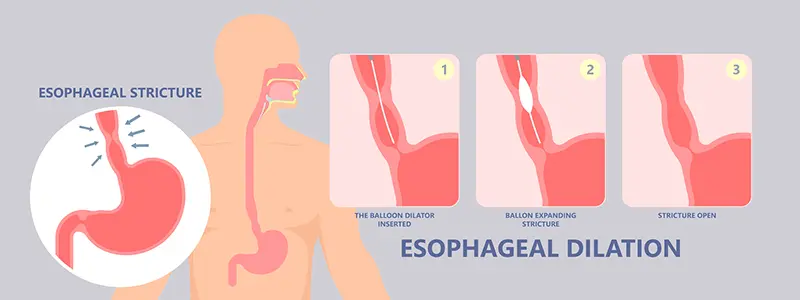At Children's Health℠, we treat more kids with esophageal strictures than almost any other pediatric hospital in the Dallas-Fort Worth area. Our deep knowledge and expertise means we have some of the best pediatric specialists in Texas. We use advanced endoscopic procedures to provide the most effective and least invasive treatments for your child. We look forward to serving your family with compassionate, high-quality care.
Overview
What is a pediatric esophageal stricture?
An esophageal stricture is a tight or narrowed area in the esophagus – the “food tube” that connects the mouth to the stomach. This condition can make it difficult for liquid and food to pass through the esophagus.
Signs and Symptoms
What are the signs and symptoms of of a pediatric esophageal stricture?
Pain when swallowing (odynophagia)
Spitting up food or liquids (regurgitation)
Coughing or gagging when swallowing
Feeling of food getting stuck in the throat
Frequent choking on foods
Frequent heartburn
Diagnosis
How is a pediatric esophageal stricture diagnosed?
Our pediatric gastroenterologists (specialists in digestive disorders) have extensive training and expertise in caring for children who have esophageal strictures.
We use advanced testing to diagnose pediatric esophageal strictures, including:
Upper endoscopy - This test involves placing an endoscope (thin tube with a camera) into the mouth and down through the esophagus to view inside.
Esophagram (barium swallow or “upper GI”) - For this procedure, your child will drink a special liquid that shows up on X-rays. We then take a chest X-ray, and the barium shows the shape and size of the esophagus more clearly.
Causes
What causes a pediatric esophageal stricture?
Typical causes of esophageal strictures in children include:
Injuries to the esophagus from accidentally swallowing small objects or harmful chemicals with lye, such as bleach, laundry detergents or batteries
Scar tissue from a previous surgery on the esophagus
Long-term use of a feeding tube
Conditions that damage or cause inflammation in the esophagus lining, such as:
Treatment
How is a pediatric esophageal stricture treated?
Medication - Our gastroenterologists may prescribe medication for your child to treat conditions that are causing the stricture, such as GERD or eosinophilic esophagitis (EoE).
Esophageal dilation - At Children’s Health, our pediatric gastroenterologists usually treat esophageal strictures with a procedure called esophageal dilation. To start, we will insert an endoscope into your child’s mouth and down into the esophagus. We then insert a tiny, deflated balloon through the tube and inflate it just enough to stretch the narrowed area.
Stent - In some cases, we place a small tube-like device (stent) in the esophagus to keep it open as it heals. Our gastroenterologists remove the stent later in a follow-up procedure.

Shutterstock_1825701950-Esophageal-Stricture-800x300
Doctors and Providers
Our team of gastroenterologists, nurse practitioners and physician assistants are highly trained and experienced in treating children with esophageal strictures. Our experts will work together to create the best care plan for your child and help relieve their discomfort.
 Bradley Alan BarthPediatric Gastroenterologist
Bradley Alan BarthPediatric Gastroenterologist Michele Jacqueline AlkalayPediatric Gastroenterologist
Michele Jacqueline AlkalayPediatric Gastroenterologist Amal Ahmad AqulPediatric Hepatologist
Amal Ahmad AqulPediatric Hepatologist Sarah Endicott BarlowPediatric Gastroenterologist
Sarah Endicott BarlowPediatric Gastroenterologist Nandini ChannabasappaPediatric Gastroenterologist
Nandini ChannabasappaPediatric Gastroenterologist Nonyelum Erica EbigboPediatric Gastroenterologist
Nonyelum Erica EbigboPediatric Gastroenterologist Aakash GoyalPediatric Gastroenterologist
Aakash GoyalPediatric Gastroenterologist Bhaskar GurramPediatric Gastroenterologist
Bhaskar GurramPediatric Gastroenterologist Lauren Kylie LazarPediatric Gastroenterologist
Lauren Kylie LazarPediatric Gastroenterologist Megha Satish MehtaPediatric Gastroenterologist
Megha Satish MehtaPediatric Gastroenterologist Derek Ming Hei NgaiPediatric Gastroenterologist
Derek Ming Hei NgaiPediatric Gastroenterologist Charina Marie RamirezPediatric Gastroenterologist
Charina Marie RamirezPediatric Gastroenterologist Norberto Rodriguez BaezPediatric Hepatologist
Norberto Rodriguez BaezPediatric Hepatologist Isabel Cristina Rojas SantamariaPediatric Gastroenterologist
Isabel Cristina Rojas SantamariaPediatric Gastroenterologist Rinarani Monish SanghaviPediatric Gastroenterologist
Rinarani Monish SanghaviPediatric Gastroenterologist Jacobo Leopoldo SantolayaPediatric Gastroenterologist
Jacobo Leopoldo SantolayaPediatric Gastroenterologist Meghana Nitin SathePediatric Gastroenterologist
Meghana Nitin SathePediatric Gastroenterologist Mhammad Gaith Said SemrinPediatric Gastroenterologist
Mhammad Gaith Said SemrinPediatric Gastroenterologist Luis Fernando Sifuentes DominguezPediatric Gastroenterologist
Luis Fernando Sifuentes DominguezPediatric Gastroenterologist David Michael TroendlePediatric Gastroenterologist
David Michael TroendlePediatric Gastroenterologist Srisindu VellankiPediatric Gastroenterologist
Srisindu VellankiPediatric Gastroenterologist Phuong LuuPhysician Assistant - Gastroenterology
Phuong LuuPhysician Assistant - Gastroenterology Van Hoang NguyenNurse Practitioner - Gastroenterology
Van Hoang NguyenNurse Practitioner - Gastroenterology Jennifer Kate PeacockNurse Practitioner - Gastroenterology
Jennifer Kate PeacockNurse Practitioner - Gastroenterology Shabina Walji ViraniNurse Practitioner - Gastroenterology
Shabina Walji ViraniNurse Practitioner - Gastroenterology